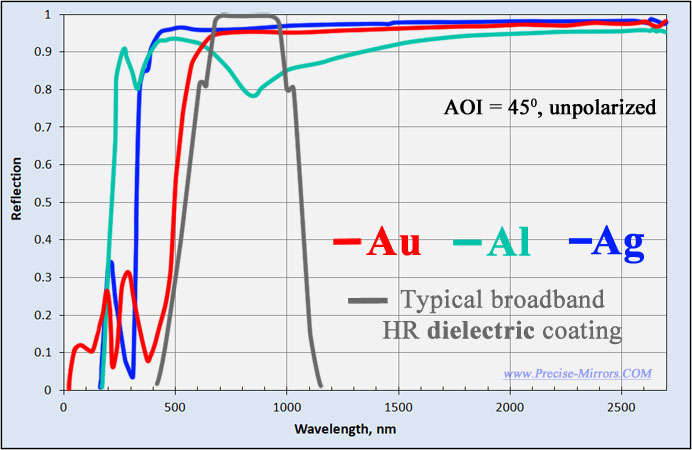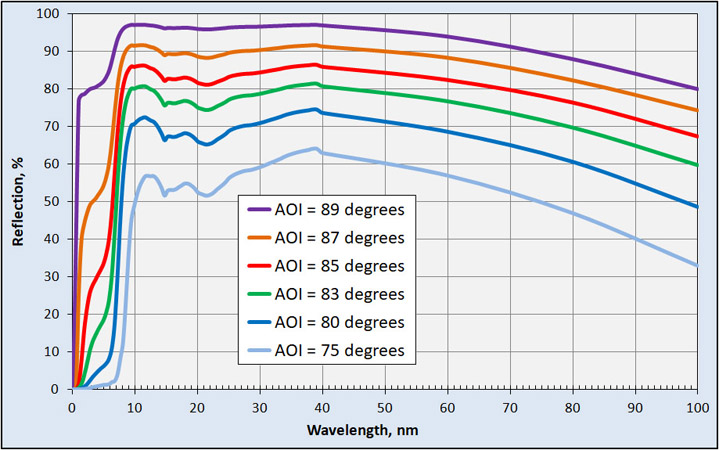
The most widespread are two types of optical coatings: metal and dielectric.
We offer coatings on new coating setup
for standard tasks and sizes mirrors no more than 200-300 mm,
average order fulfillment time is about 7-10 days.
The maximum diameter of the substrate for spraying can be up to 1200 mm
(bur for diameters more than 300 mm the order fulfillment time may increase significantly).
Mirrors with a metal coating make it possible to use them in a very wide spectral range (from 450 nm to 12 μm).
They are weakly sensitive to polarization and incidence
angle and also provide the same phase shift, making them suitable for ultrashort pulse applications.
However, these mirrors are more difficult to clean
and have a relatively low Laser Induced Damage Threshold (LIDT).

At high angles of incidence (more than 70-80 degrees),
some metal coatings can be used to work in
XUV spectral range (see below Au reflection depends on AOI).
Therefore, special metal coatings are often used to
manufacture mirrors work in the shortwaves spectral range.

Dielectric mirrors offer higher reflectivity over a broad spectral range of a few 100 nm. Their coating is more durable, making them easier to clean, and more resistant to laser damage. However, standard dielectric mirrors have several disadvantages.
First of all, dielectric mirror coatings can cause significant dispersive effects for ultrashort pulses,
that can broaden and distort short pulses (this problem is partially solved by the use of
so-called "ultrafast dielectric coatings").
Secondly, dielectric mirrors are not suitable for use in the short-wave spectral range (wavelengths less than 200-250 nm).
With an increase in the radiation power that the mirror reflects, at some point at a certain threshold value power, the reflective coating is destroyed (or, for example, the substrate surface of the mirror itself, if there is no coating). This value is called the "damage threshold" of the mirror (in English they usually write L. I. D. T.). It can be indicated in units of power per unit area, but for pulsed radiation it is customary to indicate it as units of energy per surface area unit for a pulse with certain duration. For example, if the breakdown threshold for a mirror is specified as 10 J/cm2 (for a 10 ns pulse), this means that every square centimeter of this mirror can reflect a pulse with a duration of 10 ns and an energy of 10 J.
The exact value of the damage threshold (L.I.D.T.) depends on:
--- the mirror itself (type of reflective coating, quality of coating and manufacturing of the mirror) and
--- radiation parameters (pulse energy, their duration and repetition rate, spectral range, size of the irradiated
areas, duration of irradiation and some other factors.
Mirrors with dielectric coating have the highest damage threshold (high LIDT),
average typical values for dielectric coatings are:
--- for pulsed radiation 10-20 J/cm2 (λ=1064 nm, 10 ns, 10 Hz, irradiation 1 mm2) and
--- for continuous radiation approximately 3-20 kW/cm2 (λ=1064 nm, irradiation 1 mm2).
Mirrors with a metal coating (but not the metal backing of the mirror itself) have a noticeably lower
damage threshold (lower LIDT), average typical values for metal coatings are:
--- for pulsed radiation 0.5-2 J/cm2 (λ=1064 nm, 10 ns, 10 Hz, irradiation 1 mm2) and
--- for continuous radiation approximately 0.5-1 kW/cm2 (λ=1064 nm, irradiation 1 mm2).
Using various methods, it is possible to obtain higher damage threshold values (better LIDT), e.g.
for dielectric mirrors:
--- for continuous radiation it is possible to achieve 50-150 kW/cm2 (λ=1064 nm) and
--- for pulsed radiation it is possible to achieve 70-90 J/cm2 (pulses 10 ns, λ=1064 nm).
IMPORTANT! If you change the radiation wavelength, pulse duration, or size of the irradiated area the value of the damage threshold changes strongly and nonlinearly.. Moreover, with a sufficiently large change even one of the radiation parameters (for example, pulse duration), a model of the interaction of radiation with the coating of the mirror will fundamentally change, which can change the value of the damage threshold by several orders of magnitude in one direction or another. Therefore, it is very important that a specialist assess the damage threshold for Your task.
Yes, this is possible, but please note that in this case we cannot guarantee high radiation resistance. Damage threshold (which determines radiation resistance coating) depends, among other things, on the quality and technology of processing that surface substrate on which the reflective coating will be applied. And since we can't control the preparation of this surface for coating; accordingly, we do not in this case, we can guarantee high radiation resistance of our coating.
You may:
--- or describe Your optical task in details
--- or describe specification of coating You need
Then to send us description at our email:
quote@precise-mirrors.ru.
Next, our specialists will select several options that are suitable for You.
Just describe optical production You need or describe the task You need to solve
and send us request at
quote@precise-mirrors.com